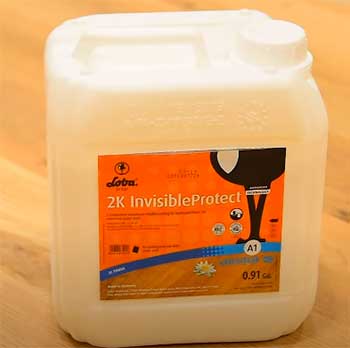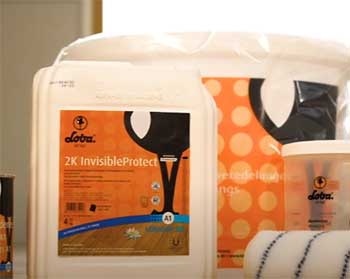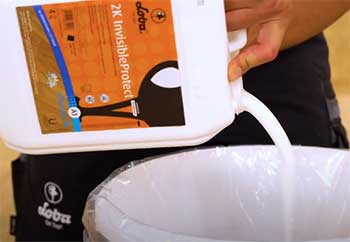Loba Invisible floor finish seems like a dream come true for hardwood floor owners. It goes on clear as day, allowing the natural color and grain of the wood to shine through beautifully.
Unlike traditional polyurethane finishes that impart an amber tone, Loba Invisible is crystal clear once cured. This water-based finish is also low in VOCs, making it a great choice for eco-conscious homeowners.
With all these benefits, what could possibly go wrong with Loba Invisible? More than you might think! While this finish offers some advantages, it also comes with its fair share of potential problems that you need to look out for.
Problems With Loba Invisible Floor Finish
- Long Cure Time

The first issue with Loba Invisible is that it takes a very long time to fully cure and harden.
The product data sheet lists a light traffic time of 24 hours and full hardness in 6-8 days.
During this drawn-out curing period, the finish is extremely vulnerable to scuffs, scratches, indentations, and other damage.
Any early foot traffic or moved furniture can leave permanent marks on the floor.
For comparison, traditional 2-part polyurethanes are usually walkable within 8-24 hours and reach full cure in 3-5 days. The quick cure minimizes the window of time when damage can occur.
With Loba Invisible, you need to be extremely careful with the floor for over a week until the finish has hardened enough.
- Susceptibility to Scratches
Even after Loba Invisible has fully cured, it is not as scratch-resistant as other finishes. Polyurethanes form a harder film due to their higher crosslinking density. Loba Invisible relies solely on the acrylic polymers to provide scratch resistance.
Over time, normal wear and tear from dirt, grit, pet nails, and other abrasives can scratch through the finish. These scratches damage the wood underneath as well.
Traditional finishes better protect the wood from scratches and wear during the floor’s lifetime. Loba Invisible does not seem to offer the same long-term scratch prevention.
Light swirl marks and scratches can appear relatively quickly after the finish has hardened.
- Difficulty Touching Up Damage
When damage does occur, Loba Invisible is very difficult to spot repair and touch up. Water-based finishes do not chemically bond with each other once cured.
Attempting to apply new finish over an existing layer results in poor adhesion. The old and new finish end up separating from each other.
With a damaged polyurethane floor, you can sand down the affected area and reapply fresh finish to blend it invisibly. This is not possible with Loba Invisible.
Any touch up will be visible due to the lack of adhesion between coats. Your only options are to live with scratches or scuffs, or sand and refinish the entire floor.
- Long-Term Durability Issues

In addition to scratching and touching up difficulties, Loba Invisible seems to suffer some durability issues long-term.
Over a period of several years, floors finished with Loba Invisible tend to show somewhat accelerated wear compared to traditional finishes.
The water-based acrylic polymers do not offer the same level of protection over the lifetime of the floor.
Areas of heavier traffic in kitchens, hallways, and entryways may start to exhibit wear several years sooner than a comparable polyurethane floor.
The finish may also develop a hazy, worn look in high traffic zones.
Loba Invisible just does not seem to withstand years of foot traffic and cleaning as well as other options. This can shorten the useful lifespan of your hardwood floors.
- Limited Moisture Resistance
Loba Invisible also has lesser moisture resistance compared to traditional oil-based or two-component water-based finishes. The single component acrylic formulation absorbs water over time.
With excessive moisture exposure, the finish can turn cloudy or milky in appearance.
Kitchens, bathrooms, and laundry rooms are particularly problematic areas. Regular water splashes and spills absorb into the finish and can permanently damage it. In contrast, polyurethane is highly water-resistant and offers much better protection in damp environments.
If you have hardwood floors in moisture-prone areas, Loba Invisible may not be the ideal choice due to its limited water resistance.
- No Warming Effect on Woodtone
Part of the appeal of Loba Invisible is that it does not alter the color tone of the wood underneath. This is great if you want to maintain the natural, untreated look of the flooring.
However, some people prefer the rich, warm amber patina that polyurethane imparts over time.
The oils in oil-based finishes penetrate into the wood and react to oxygen, gradually adding golden undertones. This gives the floor a beautiful lived-in look as it ages.
With Loba Invisible, you do not get this color enhancement effect. The woodtone remains exactly as it looked before finishing.
For some homeowners, the lack of a warming effect is seen as a drawback. The floor never develops that coveted honey-hued patina. It is a matter of personal preference, but for those who love the look of amber floors, Loba Invisible will leave you wanting.
- No Gloss Options
Currently, Loba Invisible is only available in a satin sheen. Unlike polyurethanes, you cannot get it in higher gloss levels for a shiny, wet look. The satin finish is attractive but does not offer the same reflective, liquid-like gleam as a gloss poly.
Additionally, the satin Loba Invisible seems to lose some of its luster relatively quickly. Over its lifespan, the finish develops more of a flat, matte look compared to the richer satin finish when newly applied.
For these reasons, Loba Invisible is not suitable for those desiring a high-gloss floor.
- Less Dent-Resistance

In addition to scratches, Loba Invisible also seems more prone to dents and indentations than traditional finishes.
Softer finishes like Loba Invisible are more elastic, enabling denting to occur more easily.
Polyurethanes form a harder film that better resists impacts.
In high traffic residential settings, it is not uncommon for dents and impressions to form over time even with the best finishes.
However, Loba Invisible offers less protection in this regard compared to alternatives. Dropped objects, furniture legs, stiletto heels and even pets can dent the floors more easily.
- Sticky Residue
Some users also report issues with Loba Invisible leaving a sticky residue on the surface of the wood. This sticky feeling does not go away even weeks after application. It seems to be a random side effect rather than occurring consistently.
This tacky residue could potentially attract dust, lint and other contaminants to the floor. The stickiness definitely impacts the appearance and enjoyment of the flooring. The only solution is to sand and refinish the floor to eliminate the gummy residue.
- Difficult Associates
There are also some challenges with hiring flooring contractors comfortable working with Loba Invisible. It remains a niche product in the professional hardwood flooring industry.
Many established floor refinishers are accustomed to using traditional oil-based or water-based polyurethane finishes.
Some may not want to work with Loba Invisible since it requires them to adjust their typical process. The product also has a learning curve in terms of proper application. Contractors make mistakes more often when first using this atypical finish.
Homeowners may need to search extensively for a qualified contractor willing to take on the job. Be sure to ask for examples of previous Loba Invisible projects to vet their experience.
- Environmental Impact Concerns
While low in VOCs, Loba Invisible still contains solvents and polymers that raise questions about its environmental friendliness. The acrylic polymers are essentially plastic, derived from fossil fuels. The exact proprietary ingredient list is not public either.
More natural oil finishes made from renewable botanical ingredients may appeal to homeowners wanting to take a greener approach. Oils like tung and linseed polymerize safely within the wood to form a protective finish. Loba Invisible relies on man-made chemicals to create its film.
For the most environmentally conscious consumers, Loba Invisible may not seem like the ideal choice despite its low VOC content. More discussion is warranted about its full ecological impact.
Frequently Asked Questions (FAQ)
According to the manufacturer, Loba Invisible takes 24 hours before light foot traffic is allowed. Full curing for hardness takes 6-8 days. During this extended curing period, the floors are very susceptible to scuffs, scratches, and other damage.
Loba Invisible is a water-based polyurethane floor finish that dries crystal clear. Unlike oil-based polyurethanes, Loba Invisible does not add any amber color tint to wood floors after application. It allows the natural color and grain to show through.
For routine cleaning, sweep frequently and use Loba Cleaner with a terry cloth mop. For deeper periodic cleaning, use Loba Care Remover diluted in warm water and scrub with a buffer or orbital sander. Be sure to patch test cleaners first. Avoid excessive water/liquid exposure.
The 2 component version of Loba Invisible dries more quickly than the regular single component product. Light traffic can resume after 12 hours. The finish reaches full hardness and cure in approximately 5 days. As always, be very gentle with the floor during the curing period.
Closing Remarks
Loba Invisible floor finish breaks new ground with its crystal clear, low VOC formulation. However, it has some distinct disadvantages that polyurethane alternatives do not share.
Slower curing, lower scratch resistance, difficulty with touch ups, and lesser long-term durability are chief among the concerns.
Before choosing Loba Invisible, weigh it against traditional options carefully. Make sure the benefits outweigh the potential hidden issues for your specific flooring situation.
For many homeowners, Loba Invisible offers a compelling innovation – but it is not without its downsides. Proper expectations are needed to have a satisfying experience with this unique floor finish.
